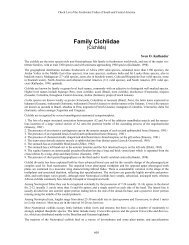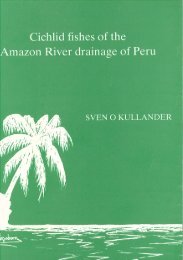Open Access PDF - Sven Kullander
Open Access PDF - Sven Kullander
Open Access PDF - Sven Kullander
Create successful ePaper yourself
Turn your PDF publications into a flip-book with our unique Google optimized e-Paper software.
Several light spots on proximal half of caudal fin.<br />
Large, partially confluent black spots with white<br />
or yellow margin on abdominal side between<br />
pectoral fin and middle vertical bar. Nuchal hump<br />
prominent, dark grey.<br />
Breeding female NRM 18023 yellowish to<br />
golden on side yellowish on cheek and gill cover,<br />
with pattern as preserved specimen. Lower jaw,<br />
chest, abdomen and ventral side of caudal peduncle<br />
white. Branchiostegal membrane orange.<br />
Light spots posterodorsally on side, light ring of<br />
caudal ocellus and spots on anal fin yellow. Light<br />
spots on pelvic fin white.<br />
Other large adults, without nuchal hump,<br />
greyish to olive on side, lower part of head, abdomen<br />
and ventral margin of caudal peduncle white;<br />
greyish on side next to anal fin base. Orange stripe<br />
from angle of mouth to lower part of subopercle,<br />
and often indistinct pale orange along abdominal<br />
side. Spots on fins white. Anal fin and lower lobe<br />
of caudal fin maroon.<br />
Etymology. Named for Dieter Kelber, in recognition<br />
of his promotion of Cichla as sport fishes, and<br />
for supporting our study with information and<br />
images of the tucunaré amarela (C. kelberi) and<br />
tucunaré azul (C. piquiti).<br />
Geographical distribution. Rio Araguaia drainage<br />
and the lower Rio Tocantins drainage (Fig.<br />
23). Introduced in reservoirs in Rio Grande do<br />
Norte, Minas Gerais and Ceará (Chellappa et al.,<br />
2003, as C. monoculus; Fontenele, 1948, as C. ocellaris),<br />
in the Rio Paraíba do Sul (State of Rio de<br />
Janeiro), and the Rio Paraná.<br />
Kelber (1999) listed Tucunaré amarela from<br />
the Itaipu, Porto Primavera, Jupiá, Três Irmãos,<br />
Ilha Solteira, São Simão, Porto Colômbia, Volta<br />
Grande, Jaguara, Estreito, Promissão, Igaratá and<br />
Paraibuna dams in the Brazilian Paraná basin, the<br />
Funil and Ribeirão das Lajes dams in the Rio<br />
Paraíba do Sul drainage, the Xingó dam in the<br />
Rio São Francisco drainage, the Pacoti-Riachão<br />
dam near Fortaleza in Ceará, the Serra da Mesa<br />
dam in the Rio Tocantins drainage. The Tucunaré<br />
amarela corresponds to C. kelberi according to<br />
photographs provided by D. Kelber.<br />
Local names. Tucunaré amarela (São Paulo,<br />
Brazil; Kelber, 1999), Tucunaré comum (Northeast<br />
of Brazil; Fontenele, 1948).<br />
Ichthyol. Explor. Freshwaters, Vol. 17, No. 4<br />
327<br />
Notes. Cichla kelberi has long been confused with<br />
C. monoculus (e.g., Fontenele, 1958, as C. ocellaris),<br />
which it resembles in shape and general colour<br />
pattern. We have not found any diagnostic character<br />
other than the light-spotted pelvic, anal and<br />
caudal fins, to separate the two species, but since<br />
this character state is unique in the genus, we are<br />
confident about species distinctness. The lateral<br />
scale count is within the higher range of C. monoculus,<br />
and below the range of C. pleiozona.<br />
The type material of Cycla toucounarai is represented<br />
by two preserved specimens, MNHN<br />
A.9490, labelled simply as coming from the<br />
“Amazone”, although the description (Castelnau,<br />
1855) also mentions “le lac des Perles de la province<br />
de Goyaz”, and the Rio Tocantins. They were<br />
referred to C. monoculus by <strong>Kullander</strong> (1986). Both<br />
specimens have characteristic blotches on the<br />
abdominal side posterior to the pectoral fin base.<br />
The larger syntype (<strong>Kullander</strong>, 1986: pl. 4 fig. 1)<br />
is a male with nuchal hump, the smaller specimen<br />
a female. The pigmentation of the smaller specimen<br />
is slightly faded on both sides, and it shows<br />
no traces of light spots on the pelvic, anal, or<br />
caudal fins. The larger specimen possesses a black<br />
occipital stripe, three prominent vertical bars<br />
dorsally on the side, and trace of a dark blotch<br />
dorsally at the root of the caudal peduncle. The<br />
pigmentation of the right side is significantly<br />
faded, but the dark pigmentation is relatively well<br />
preserved on the left side. The anal fin is brownish<br />
with indicated lighter patches distally on the<br />
scaled portion of the anterior five soft rays. The<br />
ventral half of the caudal fin is brownish with<br />
indistinct lighter mottling but without light distinct<br />
spots. The pelvic fin is brownish anteriorly<br />
with two lighter patches on anterior soft rays. The<br />
caudal spot is ringed with a prominent silvery<br />
ring in both specimens.<br />
Castelnau’s description and drawing disagree<br />
with the preserved syntypes. The drawing shows<br />
a specimen without occipital bar, and without<br />
dark blotches on abdominal side, but with three<br />
distinct vertical bars below the dorsal fin and one<br />
anteriorly on the caudal peduncle, and some red<br />
spots on the anal fin. The description apparently<br />
partly refers to the drawing, but the total length<br />
agrees with the larger syntype. Both syntypes<br />
have D. XVI.17, the drawing shows XV.18, Castelnau<br />
gives XV.17. He counts A. II.11, we count<br />
A. III.11. The pectoral fin count, 14 is in agreement.<br />
We count approximately 79 (larger syntype) and<br />
71 (smaller syntype) scales along the midline, but




